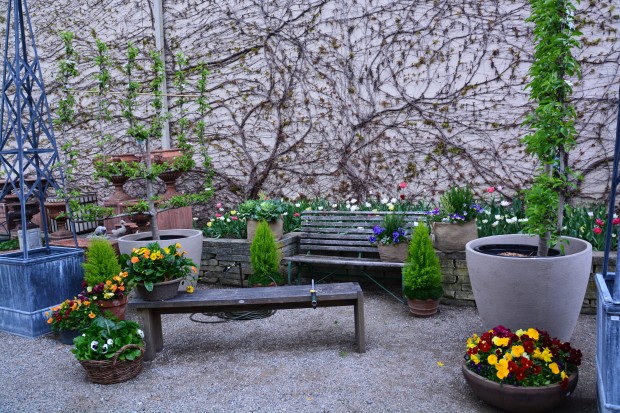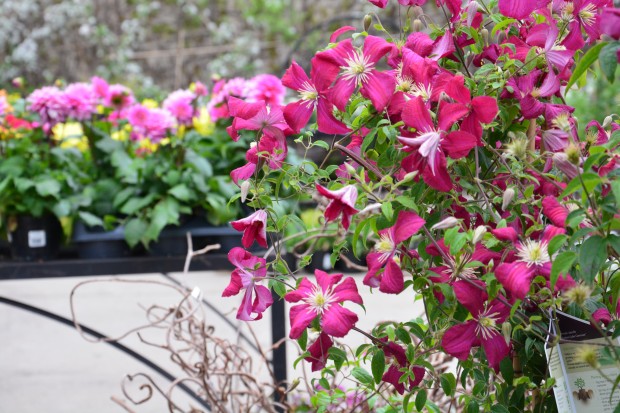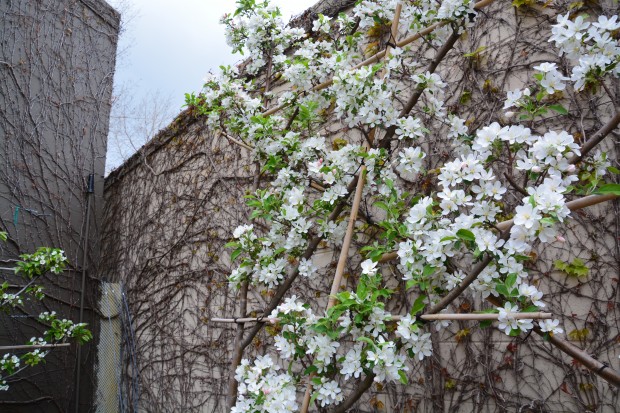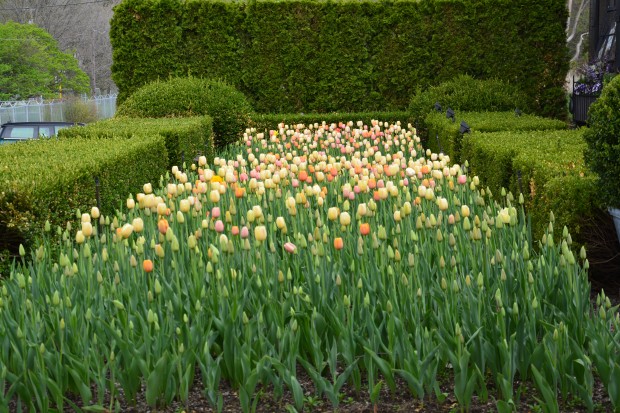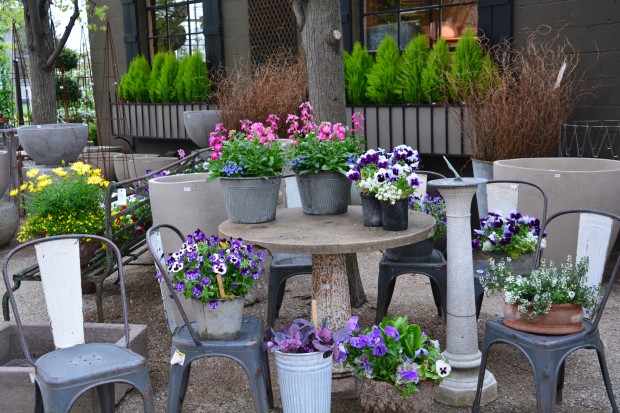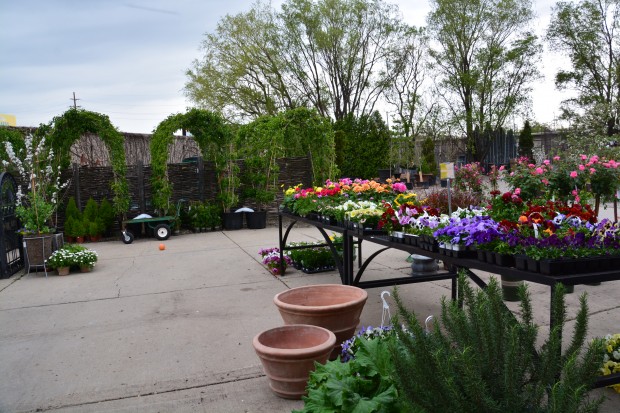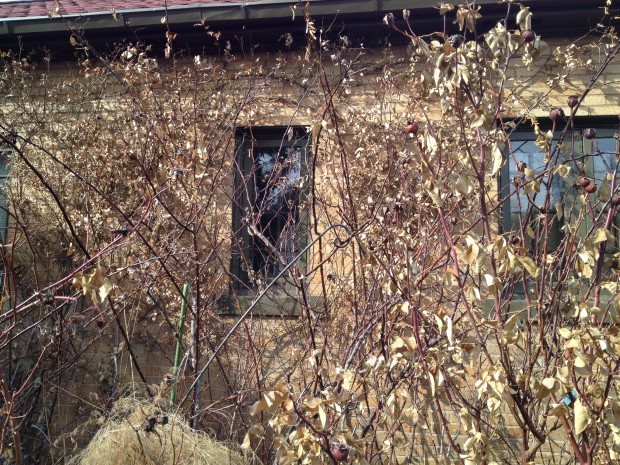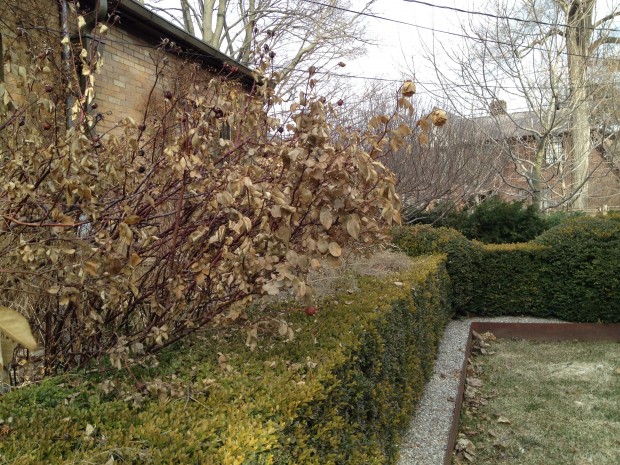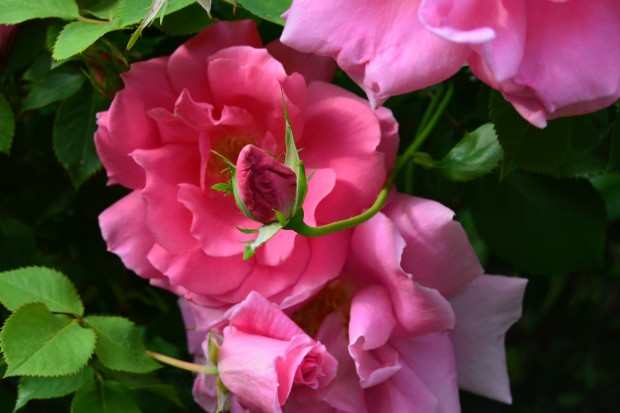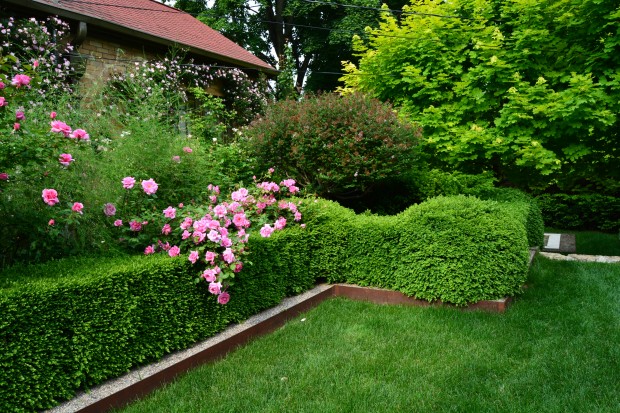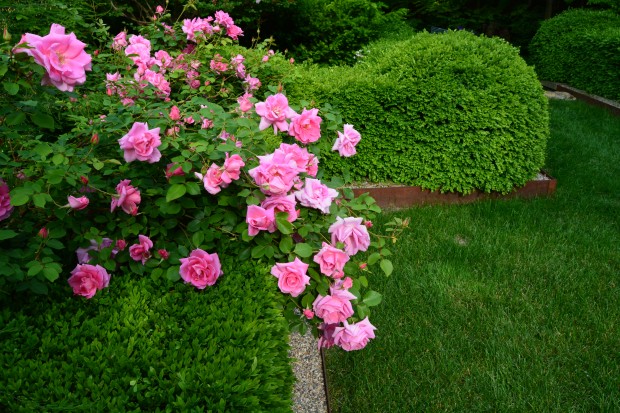 Spring is popping! Our landscape is finally beginning to green up. The living color – whether it be green, yellow red, or purple – what a relief.
Spring is popping! Our landscape is finally beginning to green up. The living color – whether it be green, yellow red, or purple – what a relief.
Archives for May 2014
At A Glance: Popping
The 2014 Espaliers
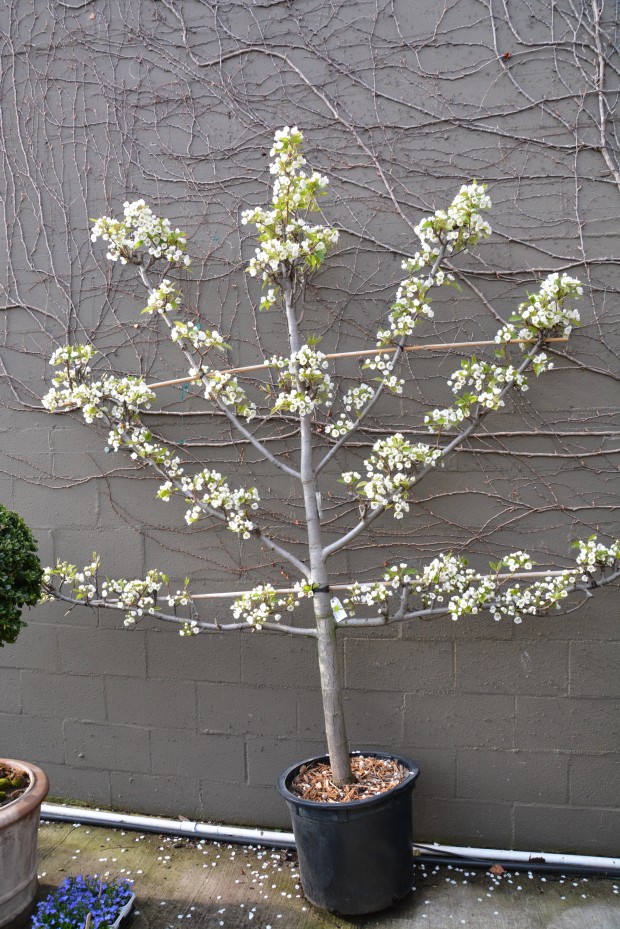 As long as I am on the topic of pruning woody plants, I would like to devote a little time to a discussion of espaliered trees. An espalier is any tree which has been trained to grow in two dimensions. Espaliers can have great height, and great width, but with next to no depth. They are pruned flat. This training can take a long time. They are great trees for very shallow places.
As long as I am on the topic of pruning woody plants, I would like to devote a little time to a discussion of espaliered trees. An espalier is any tree which has been trained to grow in two dimensions. Espaliers can have great height, and great width, but with next to no depth. They are pruned flat. This training can take a long time. They are great trees for very shallow places.
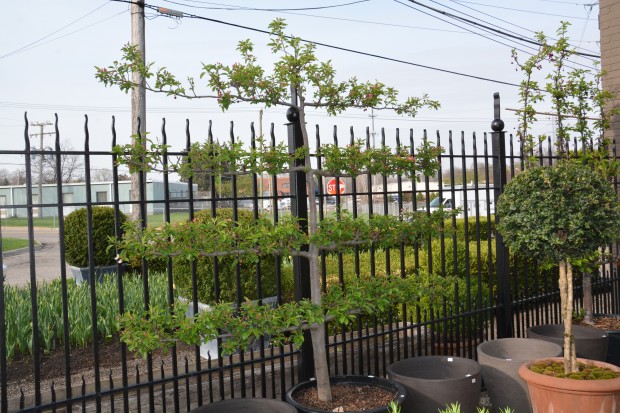 The history of growing espaliers dates back centuries, to a certain French monk, Fr. Lergendre, who was entrusted with the important job of providing food for his monastery. In those days, providing food meant growing it. Some of his discoveries were made out of sheer need. He wanted to grow lots of fruit trees, as he had lots of people to feed. The trees planted closest to the monastery walls fruited more heavily and more reliably, as the flowers were protected from late frosts by the heat generated from the walls. As his space was small, and his need great, he moved them closer and closer to the walls. And closer and closer together. There were many varieties he wished to grow. Eventually he cut the back branches off of the trees all together. Amazingly, the trees he eventually trained to grow flat against the walls produced more fruit than trees cultivated in the open. His work over a lifetime was detailed in a book he wrote, “Palmette Legendre”, published in 1684. The art of training fruit trees to grow against a wall in formally pruned shapes has persisted to this day.
The history of growing espaliers dates back centuries, to a certain French monk, Fr. Lergendre, who was entrusted with the important job of providing food for his monastery. In those days, providing food meant growing it. Some of his discoveries were made out of sheer need. He wanted to grow lots of fruit trees, as he had lots of people to feed. The trees planted closest to the monastery walls fruited more heavily and more reliably, as the flowers were protected from late frosts by the heat generated from the walls. As his space was small, and his need great, he moved them closer and closer to the walls. And closer and closer together. There were many varieties he wished to grow. Eventually he cut the back branches off of the trees all together. Amazingly, the trees he eventually trained to grow flat against the walls produced more fruit than trees cultivated in the open. His work over a lifetime was detailed in a book he wrote, “Palmette Legendre”, published in 1684. The art of training fruit trees to grow against a wall in formally pruned shapes has persisted to this day.
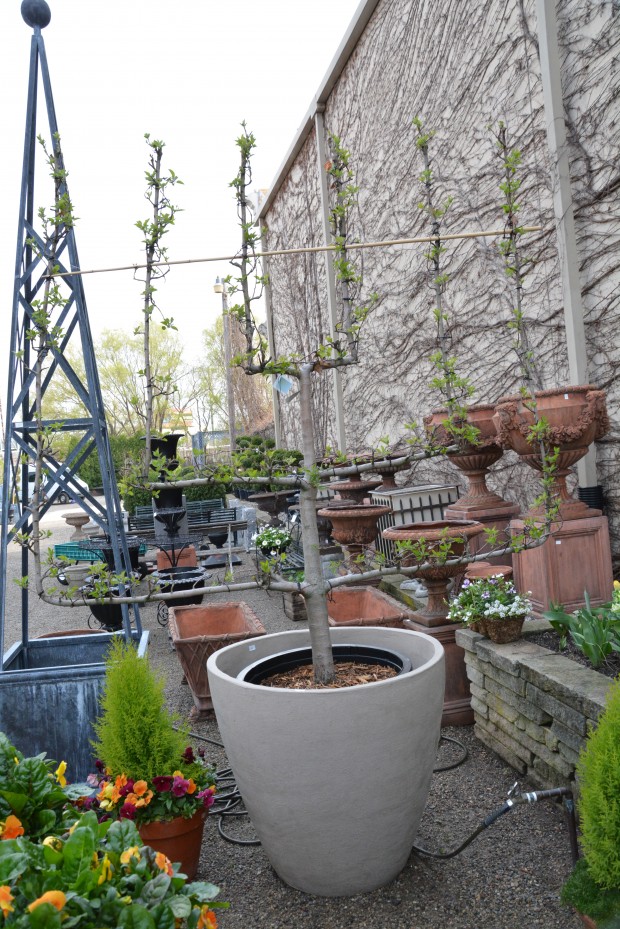 Having worked for Al Goldner in the 80’s, I inherited his love of espaliers. He actually grew them on his farm in Howell. Many a time I have gone to look at an old existing landscape with a mature espalier, and known it was his design. We buy them from a number of different growers, in different shapes and sizes.
Having worked for Al Goldner in the 80’s, I inherited his love of espaliers. He actually grew them on his farm in Howell. Many a time I have gone to look at an old existing landscape with a mature espalier, and known it was his design. We buy them from a number of different growers, in different shapes and sizes.
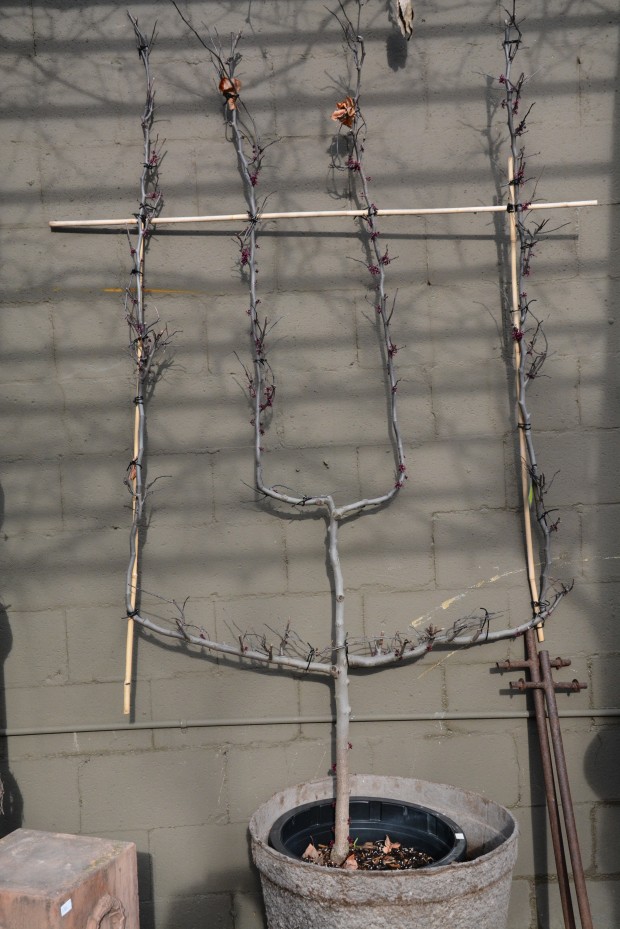 This redbud was an experimental espalier subject for one grower. It will have flowers on the main trunk this year. Almost any tree can be grown into an espalier, provided that the training and tying begins at an early age. A framework of bamboo or wire must be in place, so each branch grows the desired length and in the desired location. The process of making a branch turn from the horizontal to the vertical takes a lot of time, and must be started when the branch is young and flexible.
This redbud was an experimental espalier subject for one grower. It will have flowers on the main trunk this year. Almost any tree can be grown into an espalier, provided that the training and tying begins at an early age. A framework of bamboo or wire must be in place, so each branch grows the desired length and in the desired location. The process of making a branch turn from the horizontal to the vertical takes a lot of time, and must be started when the branch is young and flexible.
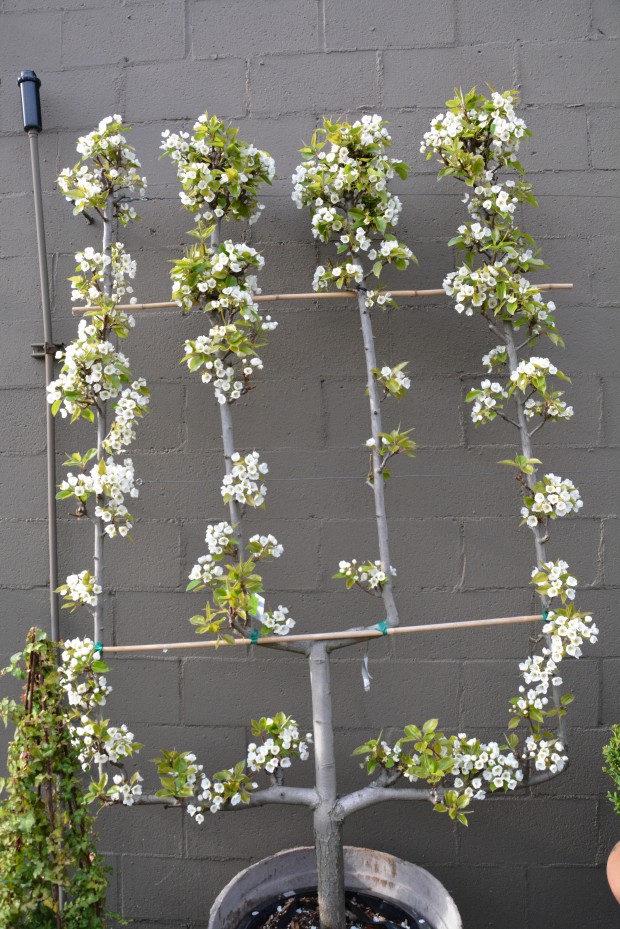 Branches on a fruiting pear tree harden off at a fairly early age. The decisions as to which shape and direction to take has to be done early on.
Branches on a fruiting pear tree harden off at a fairly early age. The decisions as to which shape and direction to take has to be done early on.
 We have a collection of 7 old fruiting pear arbors. The eighth pair has already found a home. They are outrageously beautiful. We do construct a steel hoop armature for every arbor, so the vertical branches can be tied in place. These espaliers have sufficient age and strength that they will not need that armature for long. This is plant material that can make an entire garden. Like every other plant, any gardener can grow a tree arbor, provided they have some time and patience.
We have a collection of 7 old fruiting pear arbors. The eighth pair has already found a home. They are outrageously beautiful. We do construct a steel hoop armature for every arbor, so the vertical branches can be tied in place. These espaliers have sufficient age and strength that they will not need that armature for long. This is plant material that can make an entire garden. Like every other plant, any gardener can grow a tree arbor, provided they have some time and patience.
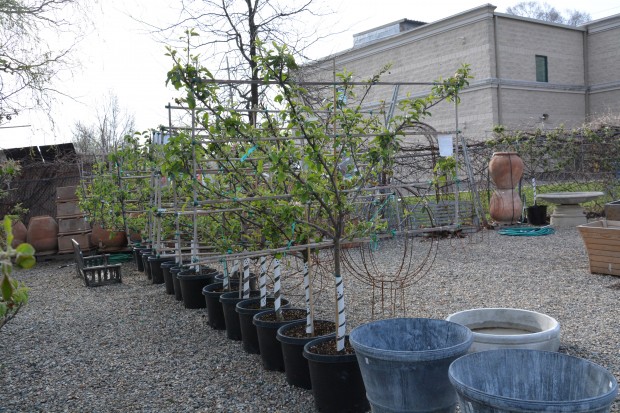 We also have a collection of 40 espalier apple trees of more modest size and dimension, and a small collection of espaliered grapes. If you have an interest in growing, training and pruning, an espalier might be a perfect addition to your garden. Interested further? I have written several essays about espaliers. If you type the word espalier into the search line of this blog, you’ll find them.
We also have a collection of 40 espalier apple trees of more modest size and dimension, and a small collection of espaliered grapes. If you have an interest in growing, training and pruning, an espalier might be a perfect addition to your garden. Interested further? I have written several essays about espaliers. If you type the word espalier into the search line of this blog, you’ll find them.
Pruning With A Purpose
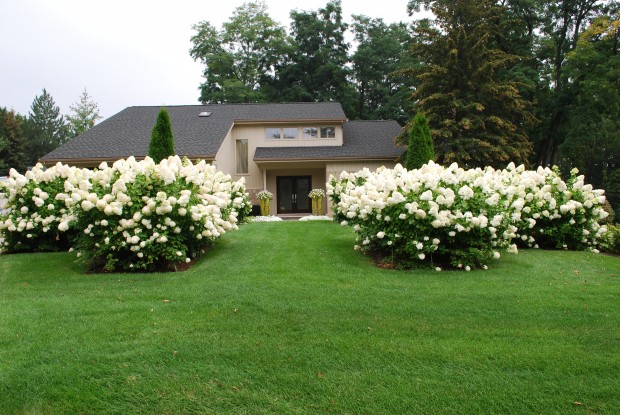
Pruning woody shrubs, when done properly, is good for the plants. Cutting out dead or diseased branches helps to preserve the overall health of the plant. Branches that cross over one another may damage the bark of both branches. Damage to the bark of a woody shrub is an invitation to insects and disease. Thinning out a woody shrub can help to maintain it at a desired size for many years. That thinning allows light and air to penetrate the interior spaces, keeping the interior of the shrub well foliated. In the hydrangea hedge above, the upper branches were kept long, a practice which eventually shaded the lower branches. The lower branches have leaves that are smaller, and fewer flowers. Once we started pruning these hydrangeas, we shortened the top branches considerably and unequally, and pruned the lower branches with the idea of encouraging lateral growth. Ideally, a hydrangea should be wider at the bottom than the top.
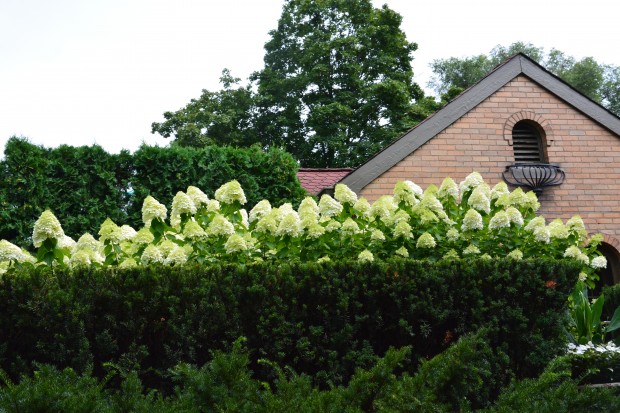 As an experiment, I did not prune my limelights at home at all last spring, but for removing the spent flower heads. My reason? I have a yew hedge in front of them. I wanted my hydangeas to grow tall, and have lots of blooms in the top third of the plant. On the inside of this hedge is a boxwood hedge, planted fairly close to the hydrangeas. For the health of the boxwood, I did not want a lot of foliage shading them. For hydrangeas blooming from top to bottom, the boxwood would have needed to be planted much further away. I did not have the luxury of that kind of space. This is what I mean by pruning with a purpose. Good pruning encourages the plant to grow in a way and direction that works with the natural habit of the plant-and the intended design.
As an experiment, I did not prune my limelights at home at all last spring, but for removing the spent flower heads. My reason? I have a yew hedge in front of them. I wanted my hydangeas to grow tall, and have lots of blooms in the top third of the plant. On the inside of this hedge is a boxwood hedge, planted fairly close to the hydrangeas. For the health of the boxwood, I did not want a lot of foliage shading them. For hydrangeas blooming from top to bottom, the boxwood would have needed to be planted much further away. I did not have the luxury of that kind of space. This is what I mean by pruning with a purpose. Good pruning encourages the plant to grow in a way and direction that works with the natural habit of the plant-and the intended design.
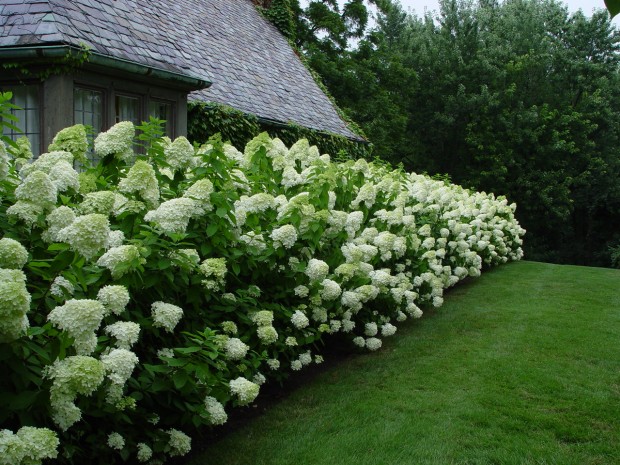
This limelight hedge was planted with the specific intent of providing dense screening from top to bottom. The branches at the bottom are slightly longer and wider than the branches at the top. Hydrangeas, like most other deciduous shrub, cannot be pruned with a hedge trimmer. Cutting every branch at exactly the same height produces a proliferation of growth all at the same level. A single cut may produce 3 or 4 breaks, or new buds. This denies light and air to the branches below. Deciduous shrubs pruned for years in this in this manner have a thin green outer layer, and a dead twiggy interior.
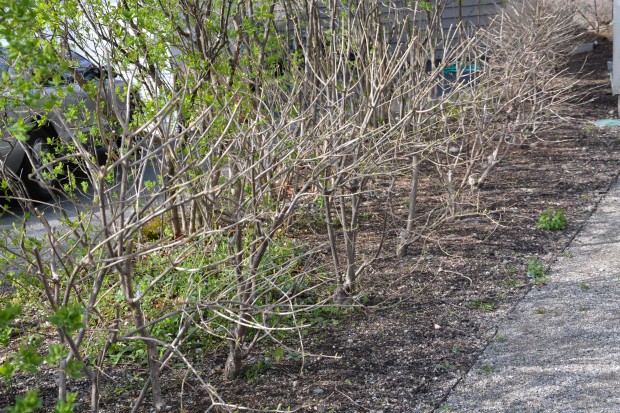 Think shag hair cut. Shorter on the top, longer on the sides, with each cut an alternate length and direction. Each branch has to be pruned individually, one at a time-each at its own level. Every branch needs a home of its own, uncrowded by the leaves of a neighboring branch. Clusters of leaves that pester one another and compete for light eventually leads to overall decline. Lots of deciduous shrubs grow large. A big shrub planted in a tight space that always needs downsizing will never look or be happy and healthy. If you don’t have room for a limelight hydrangea, which will mature at 6-8 feet tall, plant Little Limes. They can comfortably be kept at 4 t0 5 feet tall and wide.
Think shag hair cut. Shorter on the top, longer on the sides, with each cut an alternate length and direction. Each branch has to be pruned individually, one at a time-each at its own level. Every branch needs a home of its own, uncrowded by the leaves of a neighboring branch. Clusters of leaves that pester one another and compete for light eventually leads to overall decline. Lots of deciduous shrubs grow large. A big shrub planted in a tight space that always needs downsizing will never look or be happy and healthy. If you don’t have room for a limelight hydrangea, which will mature at 6-8 feet tall, plant Little Limes. They can comfortably be kept at 4 t0 5 feet tall and wide.
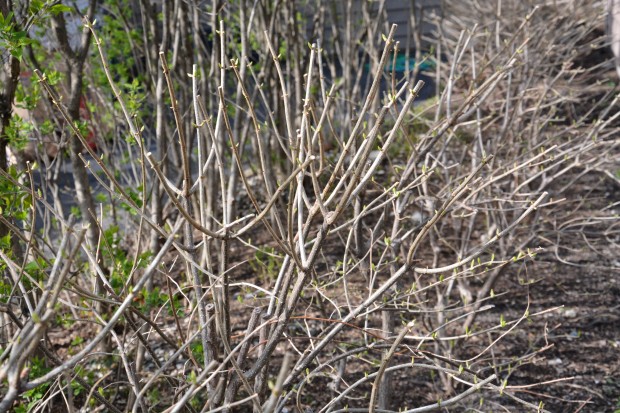
There are a few plants that are tolerant of shearing. Boxwood and yews are tolerant. Lindens have been pleached and formally grown into overhead hedges for centuries. A hydrangea is not a member of this group. They have a loose and shaggy natural shape. Pruning them needs to work with this natural habit. Landscapes where every deciduous shrub is pruned into ball, mushroom or cube shapes is a look that is heavy handed, and not good for the plants. Proper pruning takes a lot of time, but that time is well spent.
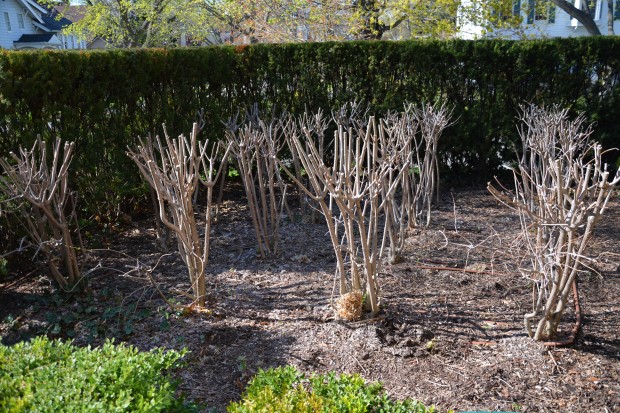 The effect of just one year not pruning my limelight hydrangeas is obvious. The shrubs have developed long bare legs Pruned down to 36″ tall will encourage lateral buds to break, and some branching at the bottom. From a distance, the boxwood disguises this legginess. In fact, I prune my hydrangeas differently every year. I like trying out different approaches and observing the results. Shrubs are quite tolerant of gardeners.
The effect of just one year not pruning my limelight hydrangeas is obvious. The shrubs have developed long bare legs Pruned down to 36″ tall will encourage lateral buds to break, and some branching at the bottom. From a distance, the boxwood disguises this legginess. In fact, I prune my hydrangeas differently every year. I like trying out different approaches and observing the results. Shrubs are quite tolerant of gardeners.
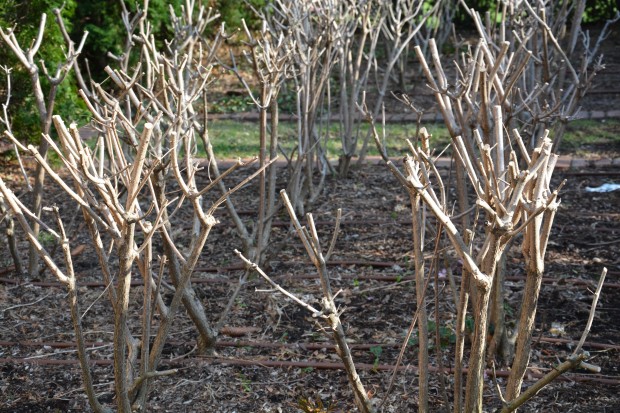 If you do have a shrub that is had become overgrown, or is suffering from long standing poor pruning, it is possible to renovate. An overgrown lilac might benefit from having a couple of old thick branches cut to the ground. This will encourage growth from the base. A privet that has been cut into a ball shape for too many years might be a good candidate for the swiss cheese treatment. Cut holes in the exterior thicket of branches so light can penetrate. The light is coming from overhead, so treating the top surface of the shrub is the most effective way.
If you do have a shrub that is had become overgrown, or is suffering from long standing poor pruning, it is possible to renovate. An overgrown lilac might benefit from having a couple of old thick branches cut to the ground. This will encourage growth from the base. A privet that has been cut into a ball shape for too many years might be a good candidate for the swiss cheese treatment. Cut holes in the exterior thicket of branches so light can penetrate. The light is coming from overhead, so treating the top surface of the shrub is the most effective way.
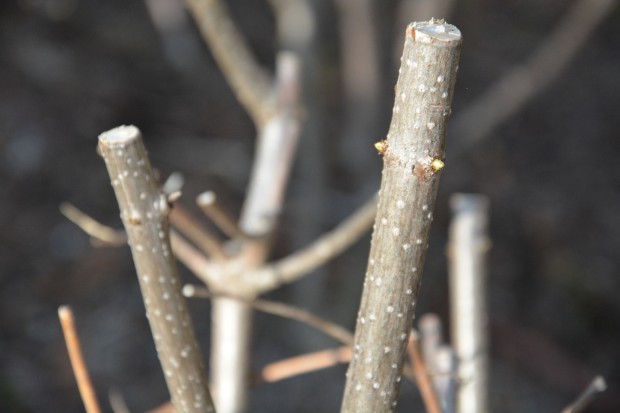 I would say my hydrangeas have been cut hard this year. I see I have buds breaking here well below the cut. The trick is to cut close enough to a bud so no time and energy is wasted on a stub that will eventually die back. Cut too close to a bud, and you may damage it. For this reason, I may prune my hydrangeas again in a month of so. To encourage more branching. Very hard pruning can result in just a few stems, with overly large flowers that droop over. A sturdily branched hydrangea properly pruned will be a joy come bloom time.
I would say my hydrangeas have been cut hard this year. I see I have buds breaking here well below the cut. The trick is to cut close enough to a bud so no time and energy is wasted on a stub that will eventually die back. Cut too close to a bud, and you may damage it. For this reason, I may prune my hydrangeas again in a month of so. To encourage more branching. Very hard pruning can result in just a few stems, with overly large flowers that droop over. A sturdily branched hydrangea properly pruned will be a joy come bloom time.
